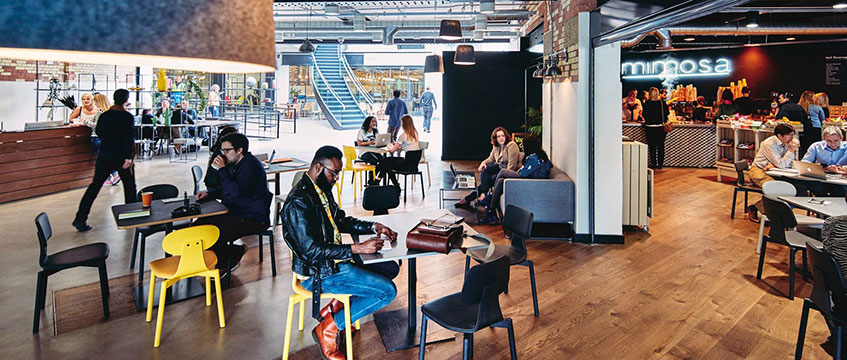Covid-19 has accelerated how office occupiers consider their real estate portfolios, with many increasingly seeking flexible solutions. This trend can be seen in the take-up of traditional office space by flexible workspace providers, which has grown significantly in the past few years. The sector continues to evolve, and it’s clear this flexibility is not a passing trend but a structural shift in the way occupiers and their employees are looking to work.
Despite this, the property industry has been sluggish to consider the valuation implications. In October 2019, the RICS published an insight paper, Valuation of Flexible Workspace, which was a crucial milestone in developing an awareness and understanding of the need for a different methodology when valuing flexible workspace.
The market is changing fast as landlords seek to compete in the same space as operators with various “products” available for occupiers, ranging from traditional serviced office accommodation to co-working space.
From a valuation perspective, it’s important to fully understand not only the type of service being provided by an operator but also the interest being valued. There is a distinct difference in the valuation approach that should be adopted for assets let on leases to operators and for assets that are owner-operated or let on management agreements.
For the purpose of this article, we have focused on the valuation of owner-operated flexible workspace. The approach adopted for different products such as “Cat A+” or “Plug and Play” is different.
Owner-occupied flexible workspace is a “trading asset” but it differs from other properties valued with reference to trading potential (such as public houses and marinas) because there is an obvious fallback position as traditional office space, which could be let to a tenant on market terms.
It is important to adopt a hybrid approach when valuing flexible workspace, considering both the trading performance of an asset and the underlying property fundamentals.
Valuation approach
We follow a three-stage approach when valuing owner-operated flexible workspace:
1. Analysis of trading performance
Complete a detailed and holistic review of historic and current trading performance, with a focus on understanding occupancy levels, revenue, operating costs, net operating income and capital expenditure projects. Key performance indicators are reviewed in the context of the wider market and benchmarked against comparable assets.
The objective is to fully understand the cashflow generated at the property as well as associated risks. This is critical in establishing appropriate capitalisation rates and accurately pricing flexible workspace assets.
2. Capitalisation of the income
Flexible workspace has an obvious alternative use as traditional office space, which underpins the value of an asset. As such, we have adopted a phased capitalisation approach. First, the net operating income (NOI) is split into two tiers:
- Tier 1 (T1) income – the amount of NOI equal to the market rent (MR) that could be achieved if the property were let on a traditional basis, less any head rent payable if the property is held leasehold. This tier comprises the most secure element of the income.
- Tier 2 (T2) income – NOI greater than the MR and typically capturing the revenue streams attributable to the flexible workspace operation and, as such, having a higher level of associated risk.
In order to reflect the different levels of risk associated with T1 and T2, a split-yield approach is adopted when capitalising the income. The yield applied to the T1 income is based on yields within the respective market that could be achieved if the property was let on a traditional basis. The yield applied to the T2 income is benchmarked against the T1 yield but discounted to reflect the increased risk associated with this tranche of income.
The level of discount applied to the T2 yield depends on the quality of the asset, how established the trade is and the quantum of the T2 income. For instance, an unproven asset or where the T2 income represents a significant proportion of the total NOI would attract a higher discount.
3. Checks and measures
The final stage involves reviewing the resulting value in the context of traditional investment metrics including the blended net initial yield, capital value per sq ft and vacant possession value.
In addition, we create cashflow models in order to analyse the ungeared internal rate of return generated and run scenarios based on hypothetical “opco/propco” and potential ground rent structures. The overall objective is to enhance the robustness of the valuation.
One size does not fit all
The disruption caused by Covid-19 has led us to look at adapting our methodology to take account of the potential short-term impact on trading performance, but this has been a very asset-specific approach.
By its very nature, property is not a homogeneous commodity. The valuation approach will vary depending on the services provided, geographical location, size of centre and maturity of the offering, as well as the underlying strength of the occupational and investment markets.
We have found that the best approach has been to combine specialist knowledge of the markets in which the property is located with the skills and expertise required to value a trading entity. In the same way that a successful operation requires a specialist, the valuation of this asset class also requires input from a mix of specialists.
Tom Nuttall is a partner and John Bareham is an international partner in Cushman & Wakefield’s valuation and advisory team










